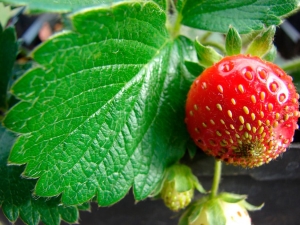Methods of dealing with diseases and pests of Victoria

One of the favorite many families of berries that can be grown on their own summer cottage, is Victoria.The fruits of this plant are tasty and beneficial to the body. But in order for the culture to please you with juicy berries for years, it is necessary to take proper care of it. This care includes the treatment of various diseases that may occur in the plant. What kind of ailments this culture may encounter, and what is the correct fight against them, will be described in detail in this article.
Disease description
There are diseases that Victoria can undergo under improper care or inappropriate growing conditions. Each of them contributes to the deterioration of one or several components of the bush, characterized by a special duration and symptoms. The most common are the following ailments.
- One of the most serious vegetable diseases is rot. In the case of this garden crop, it can be white, black, brown, and also gray. The white variety spreads at a very fast speed, especially in areas that are not weeded. The highest probability of its formation occurs during the rainy period, especially when the berries are only formed. For the disease is characterized by the appearance of white plaque, not only on the fruits themselves, but also on the leaves and rosettes. After the rot covers the plant, it begins to rot and dies. For berries at the ripening stage, the worst enemy is gray mold, which also often occurs in the rainy season.
It arises due to the absence of weeding, as well as the presence of a large number of old, dried leaves on the bushes. Grayish bloom rapidly spreads over the surface of the berries, and then goes to the green parts. Such a mold can take most of the crop.
- The black variety of this fungus. affects only the berry, which in this case rots directly on the bush. If at first such a mold is almost colorless, then in the process of spreading it acquires a black tint, the berries themselves become like boiled - they become watery, and also lose their taste and flavor. It is possible to get rid of this kind of mold only by removing infected fruit from the bed.
- When a large amount of water gets on the bed, the risk of such an illness as root mold. The leaves of the plant begin to wither, it does not bear fruit and does not develop. Dark-colored patches appear on the roots, as well as constriction.
- The leaf disease, which subsequently stylishly weakens or even kills the whole plant, is fusarium wilt. Most often it manifests itself in periods of heat and stuffiness. This disease is very persistent because it persists even in dried greens and weeds growing near it. It is important to start the treatment of this ailment promptly, since it can easily turn into a chronic one and take several years.
- Like many other garden plants, Victoria is inherent in the emergence of such diseases as powdery mildew. The presence of this disease is indicated by plaque on the reverse side of the leaf plate, an increase in its thickness, the disappearance of the ovaries, spoilage and rotting of the fruit. Most often, such a parasite spreads to Victoria, when the climate becomes wet and hot.
- One of the most dangerous diseases for Victoria is late blight rot. It affects all components of the plant, and the likelihood of the occurrence of this disease increases in conditions of overwetting. The spread of the disease begins with the deterioration of the berries, dark spots appear on them, bitterness is felt in the taste. After that, fungal formations appear on the rest of the bush, they gradually become dry. An additional danger of this disease is that harmful disputes remain not only on nearby plants and weeds, but also in the soil.
- A special type of fungus is rust. The characteristic period for its appearance is spring.This disease attacks the leaves and appears as a rusty bloom on them. The end result of the spread of spores - shrinking of greenery and the death of the plant.
- Brown spots - Another disease that manifests itself in most cases on the old strawberry leaves. First, brown spotted formations appear on them, then they become darker, black spores of the fungus appear. After this, the foliage dies off.
Pests
Among the representatives of the fauna, there are many individuals that can harm such garden culture as Victoria. Each of the parasites has a specific effect on the plant.
- White fly - an insect that parasitizes the leaves of Victoria. She lays her eggs on the back of the leaf plates. Eating the sap of the plant, the larvae grow, and the leaves of Victoria, in turn, curl and become covered with spots.
- By the end of spring, such a pest is activated as shaggy bronze. This insect eats greens on strawberry bushes, and also damages inflorescences.
- A very dangerous parasite is considered strawberry nematode. It is a small roundworm, which usually lays oval-shaped eggs on plants. Signs of the presence of such a parasite on strawberries are a change in the shape of the leaves and flowers, a darkening of the greenery, and a slower growth process. The end result is the absence of fruiting.
- Another parasite with deadly larvae for strawberries is weevil. The peculiarity of this beetle is the high rate of reproduction. Laying off many larvae, it affects a large number of cultivated plants. Victoria leaves become eaten around the edges, and the roots are also harmed. As a result, there is a general decrease in yield.
Culture Treatment Methods
To combat each of the above-mentioned garden diseases, it is necessary to apply certain treatments. Knowing them, there is a chance to save at least part of the harvest.
- Try to treat white mold at the initial stage of its appearance, because of the rapid spread of this infection, you can simply not have time to save the crop. “Switch” and “Horus” products will be excellent helpers in the treatment. They are processing diseased plants to stop the spread of plaque.
- With root disease, there is no remedy for its treatment. The only way out is to prevent its development by digging out infected bushes from the ground and tilling the soil with special means from the fungus.
- From fusarium wilt, you can use the following drugs: "Fundazol", "Trichodermin", "Horus".
- A folk remedy for powdery mildew is whey, one liter of which is diluted in 10 liters of water. Iodine is also added in the amount of 1 mg. When the weather is dry, the plants need to be treated with this mixture once every 3 days. It is also recommended to increase the plant immunity to this problem by applying mineral fertilizers.
- To save the culture from the rusty fungus will help the solution consisting of a pair of tablets "Alirina B", diluted in a liter of water. They need to handle Victoria two or three times per season.
- The treatment of the bushes “Fitosporin M”, taken in an amount of 5 grams per 10 liters of water, will help prevent the occurrence of brown spot. Spraying is done at intervals of 5 or 7 days.
Against insects, there are special means and methods.
- Folk remedies for whitefly larvae are chamomile-based decoctions, as well as infusions containing garlic. Of the finished products can be used such as "Nurell D", "Shar Pei" and "Karate".
- Folk way of dealing with bronze shaggy is burning on the bed with victoria straw and dried foliage. The smoke from such a fire is able to get rid of these bugs. Among chemical analogues stands such a tool as "Calypso".
- In order to overcome the strawberry nematode, the affected leaves were long removed from the garden bed, while in early spring heat treatment of Victoria was carried out, watered with water heated to a temperature of 50 degrees. To prevent the development of the larvae of the worm by chemical means, you need to treat the plant by such means as "Fitoverm".
- A homemade recipe for weevil is considered to be a decoction based on yarrow and black henbane. Among the finished solutions are suitable such as "Zolon", "Karate" and "Nurell D".
Prevention
In order not to worry about the appearance of ailments on such a plant as Victoria, you need to take care in advance about its correct position on the garden, as well as to carry out a number of preventive measures. All this will help prevent the occurrence of disease in the future.
- Provide enough plant space. Between the bushes is better to leave a distance of just over half a meter. If the culture is planted in rows, the most preferred width of the aisle should be 0.8 meters.
- It is necessary to regularly remove ripe berries from the bush.
- The implementation of weeding will protect your garden from the rapid spread of ailments.
- An excellent folk remedy is the use of lime on the garden, as well as ash.
- While Victoria is not yet in bloom, it needs to be treated with special compounds, such as "Barrier" or Bordeaux liquid.
- Do not neglect mulching the soil surface.
- Periodically select a new location for transplanting Victoria. At least once every three years it needs to be changed with other cultures. But remember that it is not recommended to plant strawberries on the plots after some vegetables, for example, potatoes.
- Considerable importance is the variety of strawberries. Among all the varieties on the market today, there are also options that are less susceptible to various kinds of diseases.
- It is also important not to forget about the condition of the bushes before the onset of cold weather. They are sprayed with compounds such as "Euparin" and "Topaz".
- Be sure to cut off excess leaves and whiskers.
- Clean the bed of dried leaves or grass, as they can become one of the vectors of diseases.
If you do not cure diseases in a timely manner and do not carry out their prevention, then as a result you can get small, clumsy berries or be left without a crop.
Therefore, we must timely deal with the illnesses and pests of Victoria, and even better - to prevent their occurrence in advance. For more on this, see below.








































